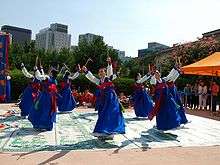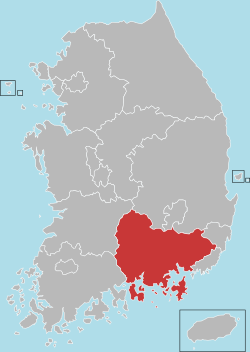Jinju
Jinju (Korean pronunciation: [tɕin.dʑu]) is a city in South Gyeongsang Province, South Korea. It was the location of the first (1592) and second (1593) Sieges of Jinju by Japanese forces during the Imjin War. The Republic of Korea Air Force Education and Training Command is located in the eastern part of the city. There are cultural-historical tourist attractions in Jinju such as Jinju Castle, the Jinju National Museum, and the Nam-gang Prehistoric Site Museum.
Jinju 진주시 | |
|---|---|
Municipal City | |
| Korean transcription(s) | |
| • Hangul | 진주시 |
| • Hanja | 晉州市 |
| • Revised Romanization | Jinju-si |
| • McCune-Reischauer | Chinju-si |
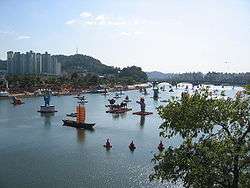 Namgang Lantern Festival held in Jinju, South Korea, 2006. | |
 Flag | |
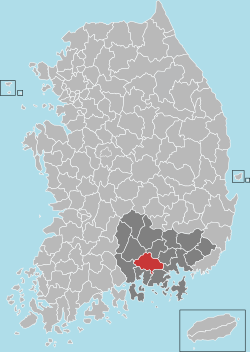 Location in South Korea | |
| Coordinates: 35°12′N 128°05′E | |
| Country | |
| Region | Yeongnam |
| Administrative divisions | 1 eup, 15 myeon, 21 dong |
| Government | |
| • Type | Mayor-Council |
| • Mayor | Cho Kyu-il (Liberty Korea) |
| • Members of National Assembly | Jinju A: Park Dae-chul (Liberty Korea) Jinju B: Kim Jae-kyung (Liberty Korea) |
| Area | |
| • Total | 712.63 km2 (275.15 sq mi) |
| Population (2010 census) | |
| • Total | 337,230 |
| • Density | 470/km2 (1,200/sq mi) |
| • Dialect | Gyeongsang |
| Area code(s) | (+82)-55- 7xx |
| Website | www |
History
From old times, Jinju was a fountainhead of national culture and spirit. As a city that has held 1,000-year-old historical heritage of the ancient city, Jinju has been well renowned as a home of patriotic spirit, education, culture and art.[1]
Jinju was an ancient city of Goryeonggaya in the Gaya Era. This city was called 'Geoyeolseong' of Baekje during the Three Kingdom Era, and was called 'Geoyeolju', 'Cheongju', and 'Gangju' during the Unified Silla Era. Name of this city was changed into 'Jinju' for the first time in the 23rd year of King Taejong of the Goryeo Dynasty (940).
It became 'Jinju-mok', one of 12 moks (local administrative units in Goryeo and Joseon Dynasty) in the 2nd year of King Seongjong (983). In the 33rd year of King Gojong of the Joseon Dynasty (1896), administrative district of the nation was reorganized with 13 provinces. At that time Jinju began to belong to Gyeongsangnam-do, and became capital town of Gyeongsangnam-do. And provincial governor started to reside in Jinju. On April 1, 1925, Busan replaced Jinju as provincial capital.
On August 15, 1949, the government of the Republic of Korea was established and 'the local self-government system' was started. At that time, Jinju-bu was raised to Jinju-si (city) and started to have mayor of the city. On January 1, 1995, in accordance with 'the Law pertaining to the establishment of Urban-Rural Integrated City', Jinju-si and Jinyang-gun became extinct and were merged into one integrated Jinju-si (city).
Culture and festivals
There are cultural events held in Jinju every year. Among these are the Jinju Namgang Lantern Festival which is held in October for approximately ten days. This nationally designated cultural tourism festival, found only in Jinju, features a spectacle of lanterns floating on the Nam River to commemorate the patriotic spirit of the 70,000 militia corps and government troops who died for their country defending Jinju from the Japanese forces during the Imjin War (1592–1598). Other major festivals include: the Nongae Festival, the Korea Drama Festival, the Gaecheon Arts Festival and the Jinju National Bullfighting Contest.
The Nongae Festival,[2] held in May each year commemorates and celebrates the sacrifice of the patriotic gisaeng (professional Korean entertainer) Nongae's suicide-assassination of a Japanese general together with the 70,000 Koreans who lost their lives in the battle of Jinju Castle during the Imjin War. The festival features an emotional reenactment of Nongae's suicidal drowning of a Japanese general from uiam bawi (righteous rock) below Chokseongnu (Jinju castle pavilion) on the banks of the Nam River.
Gaecheon Arts Festival is annually held from October 3 to 10 and the entire city turns to the streets for celebration at Korea's first provincial culture art festival, which awakens the artistic spirit of the Korean people. The festival falls around Gaecheonjeol (National Foundation Day) and is widely regarded as one of Korea's finest.
The Jinju National Bullfighting Contest is recognized as Korea's oldest bullfighting event and spectators can witness a test of strength at this bullfighting contest held at a purpose-built traditional Korean sports arena near Jinyang lake.
Population
At just over a third of a million, Jinju is a relatively small city by Korean standards. The annual growth of the population is 0.4% since 1995. People between the ages of 20 and 29 represent 17.5% of the city's total population, and justify the city's long-standing reputation as an educational city. The senior population (65 years or older), representing 7.6% of the city's total population, is higher than the provincial average (6.8%).[3] This suggests that Jinju is providing senior citizens with livable conditions, such as a variety of welfare programs and pleasant living environment.
Local personality
Gang Se-hwang, a high ranking government official and representative painter, calligrapher and art critic, was born here in 1713, son of Kang Hyeon.
Park Minhyuk, main rapper and dancer of six-membered boygroup ASTRO was also born here in 1999, Park SeongHwa vocalist from the eight-membered boygroup ATEEZ, was born here in 1998.
Jinju cuisine
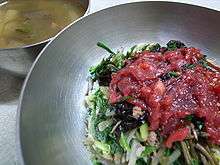
Jinju has a number of distinctive local delicacies which reflect the tastes of Jinju people. Perhaps most celebrated is Jinju bibimbap, which distinguishes itself from the common Korean rice and vegetable dish by its use of yukhoe, made with raw beef and generous amounts of sesame oil. Also famous is Namgang (Nam River) Grilled Eel (minmul jangeo), which is caught locally and served in any one of the numerous restaurants overlooking the Nam. Enjoying their food spicy, Jinjuites have also perfected a hot pepper (ttaengcho) version of the popular Korean side dish pajeon (scallion pancake) known by its colloquial name jijimi. This is best enjoyed with a bowl of local rice wine makkeolli.
Silk industry
Since ancient days, silk processed in Jinju has been known for its superior quality, which is a result of the combination of natural resources (such as clean water of Mt. Jirisan and so on) and human resources. Silk factories in Jinju annually spin out 70% of the national production. Jinju silk has a soft, refined feeling and elegant colors because of its superior dyeing techniques.
Education
Jinju is an educational city and is home to Gyeongsang National University and Chinju National University of Education, Gyeongnam National University of Science and Technology. It is also home to International University of Korea, catering mostly to foreign students. It also has a number of community colleges that serve the local area. Jinju's high schools also offer a high quality of education and have a wide catchment area, reaching beyond the city limits to attract students from surrounding towns such as: Sacheon, Hadong and Sancheong.
Universities
| Public | Private |
|---|---|
| Gyeongsang National University | International University of Korea |
| Chinju National University of Education | Yonam Institute of Technology |
| Gyeongnam National University of Science and Technology | Jinju Health College |
| Korea Polytechnic VII -- Jinju Campus |
Economy and business
Jinju was named as one of several 'enterprise cities' by the South Korean government. The government has supported Jinju as a hub of bio-industrial technological innovation from Dec. 1, 2000. The government provided 5 billion won from 2000 to 2004 in biological and chemical material industries in Jinju. There are 618 manufacturing companies (the number of employees: 11,806), 1 local industrial complex and 4 rural industrial complexes as part of an integrated urban and rural city. Jinju Hyeoksin Dosi (New innovation city) established by President Noh Moohyun (2003-2007) with headquarters of vast LH corp. (State-run Land & Housing corp Toji Jutaek gongsa) and Namdong thermal power corp. etc. Namdong thermal power is one of 5thermal power subsidiary,I.E.Nambu (Southern) thermal in Busan,Dongseo thermal in Ulsan,Seobu (Western)in Taean, Jungbu (Central) in Boryeong, Chungnam of Korea monopoly utility co.of giant Kepco in Naju of Gwangju metro head office.
Transportation
The main highway in Jinju is National Highway 10 or Namhae Expressway.
The closest airports to Jinju are Sacheon Airport (domestic) and Gimhae International Airport (International).
Jinju is served by passenger service at Jinju Station along the Gyeongjeon Line.
Climate
| Climate data for Jinju (1981–2010, extremes 1969–present) | |||||||||||||
|---|---|---|---|---|---|---|---|---|---|---|---|---|---|
| Month | Jan | Feb | Mar | Apr | May | Jun | Jul | Aug | Sep | Oct | Nov | Dec | Year |
| Record high °C (°F) | 17.5 (63.5) |
22.0 (71.6) |
24.0 (75.2) |
29.0 (84.2) |
37.0 (98.6) |
35.1 (95.2) |
38.9 (102.0) |
37.5 (99.5) |
35.0 (95.0) |
29.3 (84.7) |
27.0 (80.6) |
19.6 (67.3) |
38.9 (102.0) |
| Average high °C (°F) | 6.6 (43.9) |
9.0 (48.2) |
13.7 (56.7) |
20.0 (68.0) |
24.1 (75.4) |
27.1 (80.8) |
29.3 (84.7) |
30.3 (86.5) |
26.6 (79.9) |
21.9 (71.4) |
15.3 (59.5) |
9.5 (49.1) |
19.5 (67.1) |
| Daily mean °C (°F) | −0.1 (31.8) |
2.1 (35.8) |
6.8 (44.2) |
12.8 (55.0) |
17.6 (63.7) |
21.5 (70.7) |
25.1 (77.2) |
25.7 (78.3) |
21.0 (69.8) |
14.5 (58.1) |
7.7 (45.9) |
2.0 (35.6) |
13.1 (55.6) |
| Average low °C (°F) | −5.8 (21.6) |
−3.9 (25.0) |
0.4 (32.7) |
5.9 (42.6) |
11.5 (52.7) |
16.8 (62.2) |
21.7 (71.1) |
21.9 (71.4) |
16.4 (61.5) |
8.4 (47.1) |
1.6 (34.9) |
−4.0 (24.8) |
7.6 (45.7) |
| Record low °C (°F) | −15.9 (3.4) |
−14.3 (6.3) |
−10.4 (13.3) |
−4.2 (24.4) |
1.6 (34.9) |
8.0 (46.4) |
13.3 (55.9) |
12.1 (53.8) |
5.9 (42.6) |
−2.7 (27.1) |
−8.0 (17.6) |
−13.9 (7.0) |
−15.9 (3.4) |
| Average precipitation mm (inches) | 32.9 (1.30) |
43.0 (1.69) |
72.1 (2.84) |
118.2 (4.65) |
122.8 (4.83) |
213.0 (8.39) |
300.0 (11.81) |
316.9 (12.48) |
184.5 (7.26) |
45.0 (1.77) |
45.0 (1.77) |
19.2 (0.76) |
1,512.8 (59.56) |
| Average precipitation days (≥ 0.1 mm) | 4.7 | 5.5 | 7.6 | 8.9 | 9.3 | 10.7 | 13.6 | 12.8 | 9.5 | 5.1 | 5.5 | 3.9 | 97.1 |
| Average snowy days | 2.8 | 2.1 | 0.9 | 0.0 | 0.0 | 0.0 | 0.0 | 0.0 | 0.0 | 0.0 | 0.3 | 1.1 | 7.2 |
| Average relative humidity (%) | 62.4 | 61.8 | 62.9 | 65.2 | 70.4 | 76.0 | 81.8 | 81.0 | 78.2 | 74.0 | 70.8 | 66.2 | 70.9 |
| Mean monthly sunshine hours | 191.6 | 182.6 | 196.0 | 206.7 | 208.5 | 159.3 | 150.9 | 166.4 | 159.2 | 199.0 | 174.3 | 190.2 | 2,184.5 |
| Percent possible sunshine | 61.3 | 59.3 | 52.9 | 52.7 | 48.0 | 36.7 | 34.1 | 39.9 | 42.8 | 56.8 | 56.2 | 62.4 | 49.1 |
| Source: Korea Meteorological Administration[4][5][6] (percent sunshine and snowy days)[7] | |||||||||||||
Twin towns – sister cities
Gallery
Notable people
- Kang Ho-dong — host, comedian, former Korean traditional wrestlers.
- Go A-ra — actress, model.
- Jung So-min — actress.
- ASTRO Rocky (Park Minhyuk) — idol.
- Ateez Park Seonghwa - idol.
- GreatGuys Horyeong (Jeong Yeongki) - idol.
See also
References
- citation needed
- Miakara (28 May 2008). "miakara moments: Nongae Festival 2008".
- Home > Introduction > Status > Population Archived 2007-08-02 at Archive.today
- 평년값자료(1981–2010) 진주(192) (in Korean). Korea Meteorological Administration. Retrieved 2011-05-21.
- 기후자료 극값(최대값) 전체년도 일최고기온 (℃) 최고순위, 진주(192) (in Korean). Korea Meteorological Administration. Retrieved 9 February 2017.
- 기후자료 극값(최대값) 전체년도 일최저기온 (℃) 최고순위, 진주(192) (in Korean). Korea Meteorological Administration. Retrieved 9 February 2017.
- "Climatological Normals of Korea" (PDF). Korea Meteorological Administration. 2011. p. 499 and 649. Archived from the original (PDF) on 7 December 2016. Retrieved 9 February 2017.
- "Exchange Status". jinju.go.kr. Jinju. Retrieved 2020-04-14.
External links
| Wikimedia Commons has media related to Jinju. |
| Wikivoyage has a travel guide for Jinju. |



